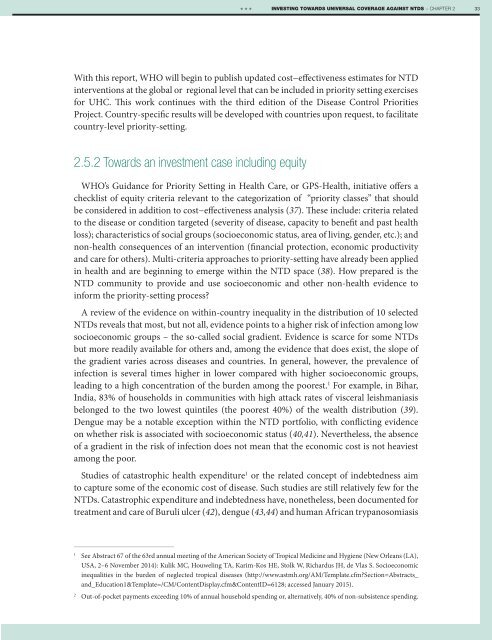1A9bnbK
1A9bnbK
1A9bnbK
You also want an ePaper? Increase the reach of your titles
YUMPU automatically turns print PDFs into web optimized ePapers that Google loves.
***<br />
INVESTING TOWARDS UNIVERSAL COVERAGE AGAINST NTDS − CHAPTER 2<br />
33<br />
With this report, WHO will begin to publish updated cost−effectiveness estimates for NTD<br />
interventions at the global or regional level that can be included in priority setting exercises<br />
for UHC. This work continues with the third edition of the Disease Control Priorities<br />
Project. Country-specific results will be developed with countries upon request, to facilitate<br />
country-level priority-setting.<br />
2.5.2 Towards an investment case including equity<br />
WHO’s Guidance for Priority Setting in Health Care, or GPS-Health, initiative offers a<br />
checklist of equity criteria relevant to the categorization of “priority classes” that should<br />
be considered in addition to cost−effectiveness analysis (37). These include: criteria related<br />
to the disease or condition targeted (severity of disease, capacity to benefit and past health<br />
loss); characteristics of social groups (socioeconomic status, area of living, gender, etc.); and<br />
non-health consequences of an intervention (financial protection, economic productivity<br />
and care for others). Multi-criteria approaches to priority-setting have already been applied<br />
in health and are beginning to emerge within the NTD space (38). How prepared is the<br />
NTD community to provide and use socioeconomic and other non-health evidence to<br />
inform the priority-setting process?<br />
A review of the evidence on within-country inequality in the distribution of 10 selected<br />
NTDs reveals that most, but not all, evidence points to a higher risk of infection among low<br />
socioeconomic groups – the so-called social gradient. Evidence is scarce for some NTDs<br />
but more readily available for others and, among the evidence that does exist, the slope of<br />
the gradient varies across diseases and countries. In general, however, the prevalence of<br />
infection is several times higher in lower compared with higher socioeconomic groups,<br />
leading to a high concentration of the burden among the poorest. 1 For example, in Bihar,<br />
India, 83% of households in communities with high attack rates of visceral leishmaniasis<br />
belonged to the two lowest quintiles (the poorest 40%) of the wealth distribution (39).<br />
Dengue may be a notable exception within the NTD portfolio, with conflicting evidence<br />
on whether risk is associated with socioeconomic status (40,41). Nevertheless, the absence<br />
of a gradient in the risk of infection does not mean that the economic cost is not heaviest<br />
among the poor.<br />
Studies of catastrophic health expenditure 1 or the related concept of indebtedness aim<br />
to capture some of the economic cost of disease. Such studies are still relatively few for the<br />
NTDs. Catastrophic expenditure and indebtedness have, nonetheless, been documented for<br />
treatment and care of Buruli ulcer (42), dengue (43,44) and human African trypanosomiasis<br />
_____________________<br />
1<br />
See Abstract 67 of the 63rd annual meeting of the American Society of Tropical Medicine and Hygiene (New Orleans (LA),<br />
USA, 2–6 November 2014): Kulik MC, Houweling TA, Karim-Kos HE, Stolk W, Richardus JH, de Vlas S. Socioeconomic<br />
inequalities in the burden of neglected tropical diseases (http://www.astmh.org/AM/Template.cfm?Section=Abstracts_<br />
and_Education1&Template=/CM/ContentDisplay.cfm&ContentID=6128; accessed January 2015).<br />
2<br />
Out-of-pocket payments exceeding 10% of annual household spending or, alternatively, 40% of non-subsistence spending.


